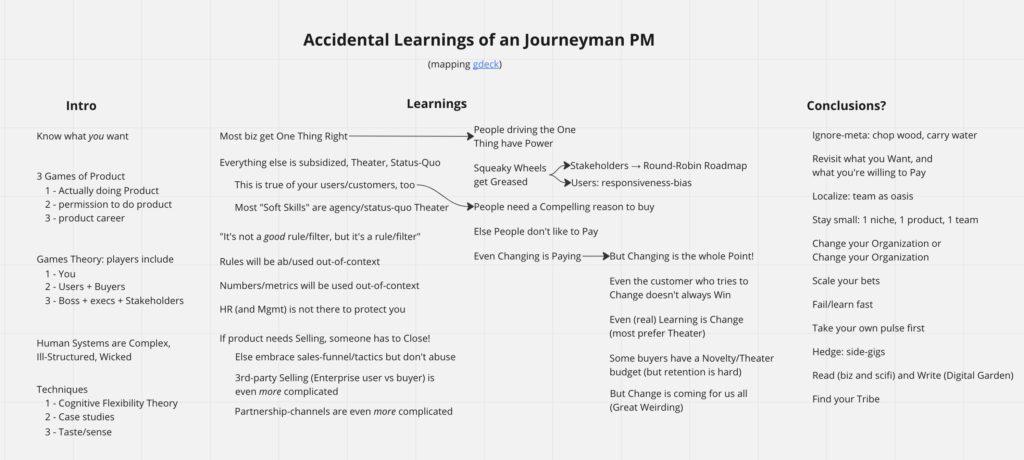Bill Seitz shares some of his learnings, so you can experience more “interesting” errors.
Accidental Learnings from a Journeyman PM by Bill Seitz
Business is a complex (not just complicated) endeavor. Most successes happen in spite of errors. And most successes are temporary, depending on your time horizon. Depending on the sources of errors, and your mindset, these can be insanely frustrating, or liberating. Bill Seitz shares some of his learnings, so you can experience more “interesting” errors.
About Bill Seitz
- Bill started his first Internet startup the year Mosaic came out.
- He has built a half-dozen product teams, as combo CTO and CPO, all in different industries, leading to 2 IPOs (1 long-delayed), and 1 strategic acquisition.
- But he still can’t afford to retire.
In the video below, Bill Seitz explains the challenges that keep product managers up at night.
In the video below, Bill shares options on what startups can do:
In the full talk, Bill addresses some key points like:
- Deciding whether to continue investing in a new feature or capability
- How do you tell if a proof of concept is driven by need or a desire for novelty?
- Navigating political landscape
- Focusing on bottleneck
Full recording
Update: Bill Seitz Offers a MindMap for Talk
SKMurphy Take
Here are my key takeaways from the talk.
- To have empathy for someone–a customer, another team member, or a prospect–you need to understand the incentives they face: what constraints, rewards, and sanctions they face for different behavior. You must understand their goals, perspective, deadlines, and other pressures.
- We operate within complex socio-technical systems where understanding people is 80% of the challenge to making improvements. We must also understand our own limits and align our goals and expectations with the change constants we face.
- Conversations with customers are invaluable, but check for selection bias in who is willing to talk to you and what they decide to disclose. Listen for what’s not said and look for categories or types of customers you have not spoken with recently.
- Every change you ask a customer to make involves the loss of the familiar, the proven, and the reliable. It asks them to risk time, money, and status in an effort that may not pay off as you promised, take longer than you propose, and, in the end, may not be superior to their status quo. Map the path to the “New World” in detail and break it up into small steps (“small bets’) that should each yield an incremental improvement. A customer is more likely to embark on a path where each step has a small cost and a small positive payoff than one where they must make a significant investment before seeing any results.
Some questions to ask yourself
- How do you define excellence at a product team level?
- What predictions are implicit in your architecture? What bets are you making?
- How do you step across the table and see other person’s operating reality? What constraints and incentives do they face from a project, technology, cultural, and career perspective?
- What practices can you build into your communication efforts to make sure that you understand the other person and they understand you.
Additional Resources from Bill Seitz
- Bill Seitz’s Slide deck
- https://www.linkedin.com/in/billseitz/
- http://webseitz.fluxent.com/wiki/FrontPage start here http://webseitz.fluxent.com/wiki/IntroPage
- From MVP to Product Market Fit
Related Blog Posts
- What is Under Your Control in an MVP
- An MVP is Finished Only After You Have Early Adopters
- A Common MVP Evolution: Service to System Integration to Product
- Concierge MVP or Service-First Forces You To Be Your Own Test Pilot
- Design Your MVP In Two Weeks
- Office Hours: Schedule Time To Walk Around Your MVP

